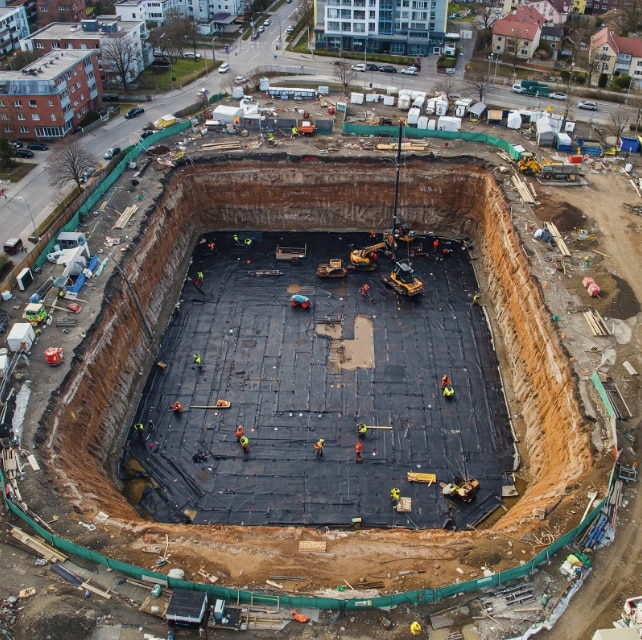Whether a building construction project is a new build or involves adaptive reuse of an existing structure, the foundation rarely generates the attention of curved glass facades or imposing columns. However, without a sturdy foundation, the most impressive new building or renovated structure is vulnerable to failures over time, such as wall cracking and other structural damage.
While some developers may prefer to spend their construction dollars on generating visual impact, a building's structural integrity is the backbone of its longevity. Below-grade waterproofing, including pre-applied waterproofing, is key to maintaining this structural integrity by preventing water intrusion below ground level. Learn more about the advantages of this waterproofing system and how it can address below-grade construction challenges.
What Is Pre-Applied Waterproofing?
Ideally, waterproofing systems are applied after a foundation is poured at a construction site, known as post-applied waterproofing. Much like a roof protects the interior of a building above ground, this sequence helps provide optimal protection against below-grade water intrusion before it reaches the foundation.
However, when excavation cannot extend beyond the outer foundation wall, pre=applied waterproofing—also known as blindside waterproofing—becomes necessary. This method is applied before rather than after pouring the foundation. Such circumstances are especially common in urban settings where structures are located in very close proximity, with sites that contain existing infrastructure, in areas with high water tables, or in buildings with zero-lot lines (where there's essentially no space between the structure and the neighboring property).
This type of waterproofing typically contains four elements applied in sequence: soil retention systems, a drainage mat, the waterproofing membrane, and finally, the concrete structural wall. Common materials used in soil retention include steel piles, wood lagging, soil nailing, shotcrete, and nets. Two layers typically comprise the drainage mat: a dimpled polypropylene membrane and an attached filter fabric. The drainage mat performs double duty by allowing water to drain away from the foundation while providing a surface to which the waterproofing membrane is applied. The final step, the waterproofing membrane, provides an unbroken barrier against water intrusion into the foundation.
What Are the Advantages of Pre-Applied Waterproofing Systems?
While post-applied waterproofing represents an optimal solution both above and below ground, it's often impractical or even impossible in situations where logistical and legal constraints are present. In such instances, pre-applied waterproofing is essential to allow construction to occur.
Getting the foundation of a building right also demonstrates an awareness of the wisdom of making that necessary upfront investment. Despite higher initial costs, if a waterproofing system works on day one, it works on day 365 and over the long term. In this context, this type of waterproofing can be thought of as an investment that's well worth the cost over the course of a building's life.
A well-executed waterproofing system can help prevent water intrusion issues, mold growth, and structural degradation from factors such as hydrostatic pressure, groundwater infiltration, and soil contaminants, all of which can lead to costly repairs and operational disruptions down the line. The cost of remediation for foundation leaks or compromised structural elements far exceeds the initial investment in high-quality waterproofing, making pre-applied waterproofing solutions a proactive and financially sound strategy.
In addition to long-term cost-effectiveness, waterproofing can help safeguard structural integrity and preserve the longevity of new or renovated construction. This longevity also supports sustainable building practices by reducing the need for repair materials and labor, helping minimize waste over the building's lifespan.
Addressing Below-Grade Waterproofing Challenges
Below-grade waterproofing systems must address a number of challenges, such as hydrostatic pressure and limited space at a construction site.
Pre-applied below-grade waterproofing systems can be especially effective at dealing with hydrostatic pressure, which is the pressure exerted by water forces. Like a bathtub's protective porcelain glaze, the waterproofing membrane used in these systems provides both a smooth surface and a waterproof barrier against water intrusion into the structure itself.
Pre-applied waterproofing solutions address complex site conditions, such as property line proximity. High groundwater levels present in many urban areas also necessitate pre-applied waterproofing systems, frequently paired with pumping arrays, to prevent water from seeping into the foundation. This combination works to help maintain dry conditions below ground, working against the forces of water that seek to fill the void created by excavation and construction, especially in coastal regions or on building sites located adjacent to rivers or lakes.
Pre-Applied Waterproofing in Adaptive Reuse
Pre-applied waterproofing solutions represent an innovative approach to adaptive reuse and renovation where buildings must be moved to add height or construct underground parking. Such projects are especially common in Washington D.C. with its many low-rise historic buildings, which are frequently targeted for reimagining as towers.
For example, consider a project in D.C. that converted a two-story historic brownstone into a tower. To accomplish this task, the building needed to be propped up to allow waterproofing around it before rejoining it with the rest of the building. pre-applied waterproofing proved critical to overcoming project constraints in this case, maintaining the historic integrity of the lower levels while allowing for the addition of a tall vertical structure on top of them.
The Assurance of High-Quality Below-Grade Waterproofing Solutions
Siplast below-grade waterproofing systems provide innovative solutions to below-grade challenges. Siplast works with a professional cadre of contractors with local connections and expertise specific to the logistical, regulatory, and other requirements of their locations.
Likewise, a newly developed line of Siplast TeraPROOF™ below-grade waterproofing solutions utilizes technology and materials that draw on the successes of its tried-and-true roofing solutions. For example, Siplast's heat-welded asphalt-based systems form a monolithic sheet, providing superior waterproofing by creating a seamless membrane with no weak points at the seams. This level of protection can help maximize the benefits—from longevity to cost-effectiveness—of a quality below-grade waterproofing system.


